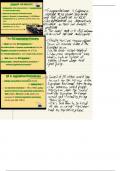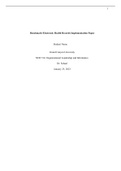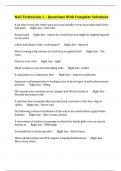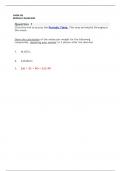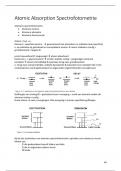A-LEVEL TEXTBOOK
NOTES
CONTENTS
CHAPTER 1 – enTERPRISE AND BUSINESS FUNCTIONS.....................................................28
Enterprise and the entrepreneur...................................................................................28
Factors of production.................................................................................................... 29
Adding value................................................................................................................. 29
Constraints on a business.............................................................................................29
The functions within a business....................................................................................29
Chapter 2 – Business sectors and types of business........................................................30
Different stages of production.......................................................................................30
Business activity........................................................................................................... 30
Structure of the economy............................................................................................. 30
Types of business.......................................................................................................... 31
Businesses in the private sector...................................................................................31
Sole trader.................................................................................................................... 31
Advantages of being a sole trader.............................................................................31
Disadvantages of being a sole trader.........................................................................31
Partnership................................................................................................................... 32
Advantages of partnerships.......................................................................................32
Disadvantages of partnerships..................................................................................32
Limited liability partnerships.........................................................................................33
Limited company.......................................................................................................... 33
private and public limited companies...........................................................................33
Advantages of companies..........................................................................................34
Disadvantages of companies.....................................................................................35
Public sector................................................................................................................. 35
Third Sector.................................................................................................................. 35
Chapter 3 – Franchises and co-operatives........................................................................36
Franchises..................................................................................................................... 36
, Advantages for the franchiser....................................................................................36
Disadvantages for the franchiser...............................................................................36
Advantages to the franchisee....................................................................................36
Disadvantages to the franchisee................................................................................37
Co-operatives................................................................................................................ 37
Advantages of a co-operative....................................................................................37
Disadvantages of a co-operative................................................................................37
Number of employees................................................................................................... 38
Number of factories, shops or offices............................................................................38
Turnover and profit levels............................................................................................. 38
Stock market value....................................................................................................... 38
Capital employed.......................................................................................................... 38
EU Definitions of business size......................................................................................39
Factors affecting the size of a business.........................................................................39
Market size................................................................................................................ 39
Nature of the product................................................................................................ 39
Personal preference................................................................................................... 39
Ability to access resources for expansion..................................................................39
External growth: the Growth of a business...................................................................40
The effect of a business’s size on its stakeholders........................................................40
Organic growth............................................................................................................. 41
Mergers and acquisitions.............................................................................................. 41
Joint ventures................................................................................................................ 41
Why undertake a joint venture?.................................................................................42
Strategic alliance.......................................................................................................... 42
Are joint ventures and strategic alliances beneficial for the business’s stakeholders?
.................................................................................................................................. 42
Chapter 5 – Stakeholders.................................................................................................43
Owners.......................................................................................................................... 43
Employees.................................................................................................................... 43
Customers..................................................................................................................... 43
Suppliers....................................................................................................................... 44
Lenders......................................................................................................................... 44
The community............................................................................................................. 44
The government............................................................................................................ 44
Chapter 6 – Different stakeholder objectives and mission statements.............................44
Mission statement......................................................................................................... 44
Aims or goals................................................................................................................ 45
, Objectives..................................................................................................................... 45
Hierachy of objectives................................................................................................ 45
Strategic objectives................................................................................................... 45
Tactical objectives..................................................................................................... 46
Setting objectives: Smart...........................................................................................46
Constraints.................................................................................................................... 46
Changing objectives................................................................................................... 47
Communications and objectives................................................................................47
Chapter 7 – Strategy and implementation........................................................................47
Strategic management and planning............................................................................47
Objectives, strategy and tactics.................................................................................47
Developing a strategy................................................................................................ 47
interal audit............................................................................................................... 47
External audit............................................................................................................ 48
Political...................................................................................................................... 48
Economic................................................................................................................... 48
Social......................................................................................................................... 49
Technological............................................................................................................. 49
Competition............................................................................................................... 49
Culture....................................................................................................................... 49
Ethics......................................................................................................................... 49
Using the information................................................................................................49
Stakeholder objectives..................................................................................................50
Stakeholder conflicts..................................................................................................... 50
Stakeholder influence................................................................................................... 50
Employees................................................................................................................. 50
Shareholders.............................................................................................................. 50
Suppliers.................................................................................................................... 50
Local community........................................................................................................ 51
Creditors.................................................................................................................... 51
The legal situation........................................................................................................ 51
Porter’s five forces model.............................................................................................51
Models of strateigic choice............................................................................................ 52
Porter’s generic strategies......................................................................................... 52
Management by objectives...........................................................................................52
Chapter 8 – Business plans and contingency crisis management....................................53
Business plans.............................................................................................................. 53
Business plans for start-ups..........................................................................................53
, Business plans for established companies....................................................................53
The benefits of a strategic review.................................................................................53
Why is a plan important for business stakeholders.......................................................54
Advantages of a business plan......................................................................................54
Disadvantages of a business plan.................................................................................54
What should a business plan aim to include?................................................................54
The plan-do-review process..........................................................................................55
Advantages................................................................................................................ 56
Disadvantages........................................................................................................... 56
contingency planning and crisis management..............................................................57
Crisis management....................................................................................................... 58
What should be done in a crisis?...................................................................................58
Chapter 9 – Risk and uncertainty and opportunity cost....................................................59
Uncertainty................................................................................................................... 59
uncertainty, risk and setting objectives........................................................................59
Risks associated with external and internal factors...................................................59
Management of risks..................................................................................................... 60
Economic risk could be managed by:.........................................................................60
Political risk could be managed by:............................................................................60
Competitive risk could be managed by:.....................................................................61
Organisational risk could be managed by:.................................................................61
Stakeholder risk could be managed by:.....................................................................61
Personal risk................................................................................................................. 61
Decision making, risk and opportunity cost..................................................................61
Chapter 10 – forecasting..................................................................................................62
Methods of forecasting.................................................................................................. 62
Qualitative forecasting.................................................................................................. 62
Qualitative forecasting methods...................................................................................62
Quantitative methods: Time series analysis..................................................................62
Finding the trend....................................................................................................... 63
Calculating the cyclical variation...............................................................................64
Summary for calculating a moving average and using it to forecast.........................64
Use and limitations of forecasts....................................................................................64
Decision making and conflicts in decision making...........................................................65
Ansoff’s martrix............................................................................................................. 65
Market penetration.................................................................................................... 66
Market development..................................................................................................66
Product development................................................................................................. 66
, Diversification............................................................................................................ 66
Ansoff’s matrix in practice.........................................................................................66
Conflicts in decision making..........................................................................................66
Stakeholders and decisions........................................................................................... 67
Chapter 12 – Decision trees............................................................................................. 67
The diagrams................................................................................................................ 67
Calculating the expected values...................................................................................67
The benefits and limitations of using decision trees.....................................................68
Benefits...................................................................................................................... 68
Limitations................................................................................................................. 69
Chapter 13 – The market including physical and non-physical markets...........................69
The market................................................................................................................... 69
How can a market be classified?...................................................................................69
Competitive markets.................................................................................................69
Monopoly................................................................................................................... 70
Monopolistic competition........................................................................................... 70
Oligopoly.................................................................................................................... 70
Market size and growth.................................................................................................70
Competition and market dominance..........................................................................70
Barriers to entry......................................................................................................... 71
Barriers to exit........................................................................................................... 72
Organic growth............................................................................................................. 72
Mergers and acquisitions.............................................................................................. 72
Regulation and restriction of market dominance in the uk............................................72
Chapter 14 – Demand supply and market forces.............................................................73
Demand........................................................................................................................ 73
Supply........................................................................................................................... 73
Equilibrium price........................................................................................................... 74
What are the factors that determine demand?.............................................................75
Price.............................................................................................................................. 75
Income.......................................................................................................................... 75
Wealth.......................................................................................................................... 75
Advertising, promotional offers and public relations.....................................................75
Taste and fashion.......................................................................................................... 75
Demographic changes..................................................................................................75
Government action....................................................................................................... 75
The price of other goods............................................................................................... 76
Substitutes................................................................................................................. 76
, Complements............................................................................................................. 76
What are the factors that determine supply?................................................................76
Price.............................................................................................................................. 76
Costs............................................................................................................................. 76
Taxes and subsidies...................................................................................................... 77
tax............................................................................................................................. 77
Subsidy...................................................................................................................... 77
Price of other products..................................................................................................77
Interaction of demand and supply.................................................................................77
Increases in demand..................................................................................................77
decreases in demand................................................................................................. 77
Increase in supply...................................................................................................... 78
Decrease in supply.................................................................................................... 78
Elasticity of demand..................................................................................................... 78
Key term – Elastic...................................................................................................... 78
Key term – inelastic................................................................................................... 78
Chapter 15 – The European Union, emerging markets and the global context.................78
Free trade and the single market..................................................................................79
Trade barriers............................................................................................................... 79
Removal of trade barriers..........................................................................................79
What are the implications of trading in the EU for a uk Business?................................80
Expansion of the euro................................................................................................... 81
The euro........................................................................................................................ 81
Advantages to UK businesses of joining the euro..........................................................81
it would encourage trade...........................................................................................81
Prices would be more transparent.............................................................................81
Less uncertainty over costs and profits......................................................................81
Diadvantages to UK businesses of joining the euro.......................................................82
Loss of control over monetary policy.........................................................................82
‘Outer’ countries may get left behind........................................................................82
At what exchange rate should the pound join the euro?...............................................82
Continued EU membership...........................................................................................82
Global context............................................................................................................... 83
Emerging markets......................................................................................................... 84
Advantages and disadvantages of globalisation...........................................................84
Advantages................................................................................................................ 84
Disadvantages........................................................................................................... 84
Opportunities and threats of globalisation....................................................................85
,Chapter 16 – International trade and free trade...............................................................85
Free trade..................................................................................................................... 85
What are the implications of international trade for a uk business?..............................87
exchange rate............................................................................................................... 88
How is the exchange rate determined?......................................................................88
What determines the demand for pounds?................................................................88
What determines the supply of pounds?....................................................................88
what are the effects on a business if the rate of exchange chages?..........................89
Bank of england and the exchange rate.......................................................................89
Hot money.................................................................................................................... 89
The exchange rate as a tool of economic policy...........................................................89
Inflation...................................................................................................................... 89
Economic growth....................................................................................................... 90
Are all businesses affected the same way by changes in the exchange rate?..............90
UK business that exports but does not import...........................................................90
UK business that imports but does not export...........................................................90
UK business that both imports and exports...............................................................91
Summary................................................................................................................... 91
Analysing and evaluating the effects of a change in the exchange rates......................91
Percentage................................................................................................................. 91
Trend......................................................................................................................... 91
Extent........................................................................................................................ 92
Duration..................................................................................................................... 92
What support is available for businesses that trade internationally?............................92
Avoiding the effects of a change to exchange rate....................................................92
Export factoring......................................................................................................... 92
Export insurance........................................................................................................ 92
Training and support for exporters from the government..........................................92
Chapter 17 – Political, social and ethical factors..............................................................93
European Union............................................................................................................ 93
Central government intervention..................................................................................93
Competition policy..................................................................................................... 94
Privatisation and reregulation....................................................................................94
Labour markets.......................................................................................................... 94
Labour market and supply-side policies.....................................................................95
Minimum wage.......................................................................................................... 95
Examples of effects of political factors on functions of business................................95
Social issues.................................................................................................................. 96
, DEMOGRAPHIC CHANGES.............................................................................................96
Changes in the age of the population........................................................................96
Ethnic diversity.......................................................................................................... 96
Changing patterns in employment.............................................................................96
Education................................................................................................................... 96
Flexibility................................................................................................................... 97
Technology................................................................................................................... 97
Agency work................................................................................................................. 97
Implications of social change on demand.....................................................................97
Ethical issues................................................................................................................ 97
Benefits of ethical behaviour.....................................................................................98
Corporate social responsibility...................................................................................98
Environment and ethical issues.................................................................................98
charity and fundraising.............................................................................................. 98
Diversity.................................................................................................................... 98
Financial responsibility...............................................................................................98
Chapter 18 – Economic factors: GDP and the business cycle...........................................99
the nature of economic activity....................................................................................99
WHAT IS ‘THE ECONOMY’?.........................................................................................99
Nature of economics..................................................................................................99
What is ‘economic activity’?......................................................................................99
Factors that affect economic activity.......................................................................100
What happens to GDP when the variables change?.................................................101
What happens to economic activity if leakages do not equal injections?.................101
Business cycle............................................................................................................. 101
What happens at each stage of the cycle?...............................................................102
Boom....................................................................................................................... 102
Recession................................................................................................................. 102
Slump...................................................................................................................... 102
Recovery.................................................................................................................. 102
Effects of changes in economic activity on businesses...............................................102
How could a firm use the business cycle to its advantage?........................................102
How may a business evaluate where the economy is on the economic cycle?...........103
Why does the business cycle exist?............................................................................103
Chapter 19 – economic factors: economic policy...........................................................103
Macroeconomic objectives..........................................................................................104
Low and stable rate of inflation...................................................................................104
High level of employment........................................................................................... 104
, Economic growth........................................................................................................ 104
Balance of payments equilibrium................................................................................105
Economic policy and its effect on businesses..............................................................105
Monetary policy.......................................................................................................... 105
Effects of a rise in the rate of interest on businesses..................................................106
Effects of a fall in the rate of interest on businesses...................................................106
‘Credit crunch’............................................................................................................ 106
Fiscal policy................................................................................................................ 107
Taxation...................................................................................................................... 107
Direct taxes............................................................................................................. 107
Indirect taxes........................................................................................................... 107
Public spending........................................................................................................... 108
Supply-side policies..................................................................................................... 109
evaluating the effects of a change in economic policy................................................109
Chapter 20 – legal factors.............................................................................................. 109
Civil law...................................................................................................................... 110
Criminal law................................................................................................................ 110
EU law......................................................................................................................... 110
Why have laws?.......................................................................................................... 110
Laws governing the relationship between businesses.................................................110
Contract law............................................................................................................. 110
COmpetition law...................................................................................................... 111
Laws governing consumer protection.........................................................................111
Sale of goods act (2012 and 1979)..........................................................................111
Consumer protection from unfair trading regulations (CPRs) and trade descriptions
act (1968)................................................................................................................ 111
WEights and measures act.......................................................................................111
Unsolicited goods act............................................................................................... 112
DATA PROTECTION ACT...........................................................................................112
Prevention of discrimination....................................................................................112
National minimum wage act....................................................................................112
Health and safety..................................................................................................... 112
SMoking in the workplace........................................................................................... 113
The Health and safety executive (HSE).......................................................................113
Termination of employment........................................................................................113
Redundancy............................................................................................................. 114
Dismissal................................................................................................................. 114
What happens if a business breaks the law?...............................................................114
, Strategic approach to complying with the law............................................................114
Strategic benefits of complying with the law..............................................................114
Chapter 21 – Environmental and technological factors and external factors and influence
....................................................................................................................................... 115
Effects of technology on business...............................................................................115
Perceived disadvantages.........................................................................................115
Benefits of technological change.............................................................................115
Implementing technological change...........................................................................116
Advantages and disadvantages of using computer software......................................116
Advantages.............................................................................................................. 116
Disadvantages......................................................................................................... 116
Examples of effects of technological issues on business..........................................117
Digital technology....................................................................................................... 117
The impact of the digital revolution.........................................................................117
Opportunities and threats for businesses that have arisen due to the digital revolution
................................................................................................................................... 118
Opportunities........................................................................................................... 118
Threats.................................................................................................................... 118
Environmental factors.................................................................................................118
Air pollution............................................................................................................. 119
Noise pollution......................................................................................................... 119
River or sea pollution...............................................................................................119
Land pollution.......................................................................................................... 119
Congestion............................................................................................................... 119
GOvernment measures............................................................................................... 119
Sustainable development strategy..........................................................................119
Climate change levy................................................................................................ 120
Carbon trust standard.............................................................................................. 120
The Carbon Trust..................................................................................................... 120
Congestion charges.................................................................................................120
Alternative sources of energy..................................................................................120
Pressure groups.......................................................................................................... 120
Conflict between environmetnal and ethical concerns and other objectives...............120
Examples of the effects of environmental issues on business..................................121
Chapter 22 – Causes and effects of change and managing change...............................121
Communication and change.......................................................................................121
Causes of change........................................................................................................ 121
Internal change........................................................................................................... 122


